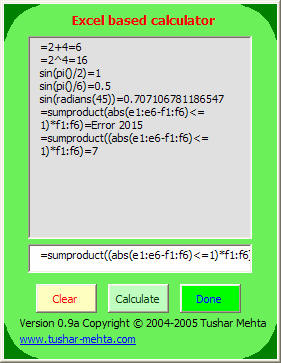This add-in implements an Excel based calculator. In versions 2000 and later it is a floating calculator so that one to use the calculator and Excel at the same time.
Enter any legitimate Excel formula including an array formula that returns a single result and the calculator will show the result in the scrollable gray box.
 |
Why would anyone want to use a calculator with Excel?
I find that there are times I want a quick answer to a question. I don't want to use the worksheet I am working on for a one-off calculation.
At other times, I want a trace of formulas and the corresponding results as I'm working through a problem. This calculator satisfies both requirements.
See the common installation instructions on the website at Common Installation Instructions.
 |
Access the calculator with the TM | Utilities ► Calculator... menu item. In Excel 2000 or later, the calculator will be a floating window that lets you interact with Excel without having to close the calculator.
Enter the formula you want in the white textbox. Press the ENTER key or click the Calculate button to see the result in the big grey box.
The formula and the result will show up at the bottom of the grey box. Once it fills up, you can scroll up and down to see all the results.
The text in the grey result box is selectable. This lets you copy it somewhere else. It also means you can selectively delete only a part of the text. If no text is selected when the Clear button is clicked, the result box will be totally cleared. If some text is selected, only that text will be deleted.
Click the Done button when done with the calculator.
Those readers who have worked on large software projects know that only 10-20% of the code in a program is the core functional code. The rest is error handling and user interface code. This add-in takes it to an extreme. The real code is only one line! All the other modules -- standard modules, class modules, ThisWorkbook module, what-have-you, are all UI or error code. In fact, even the error code is relatively small comprising of under a dozen lines.
The add-in uses a standard userform that has been customized by removing the caption block. The code to do this is fairly standard. It's available in the latest book by Bullen, Bovey, and Green, and on various websites such as the one maintained by Ivan Moala. The reader can also check msdn.microsoft.com and Karl Peterson's VB site. In my case, I started with Ivan's API declarations (of course, one could just as easily start with the CD that goes with the book by Bullen et al. or any of the other websites mentioned) and modified the code to suit my own requirements.
Scrolling calculator audit trail log adding machine custom userform
The author's email address is web-underscore-contact-at-tushar-hyphen-mehta-dot-cee-oh-em.